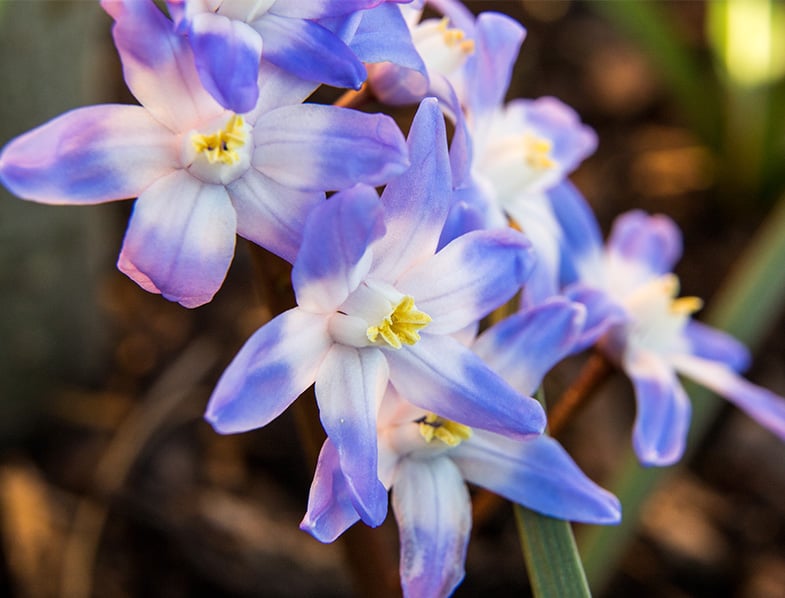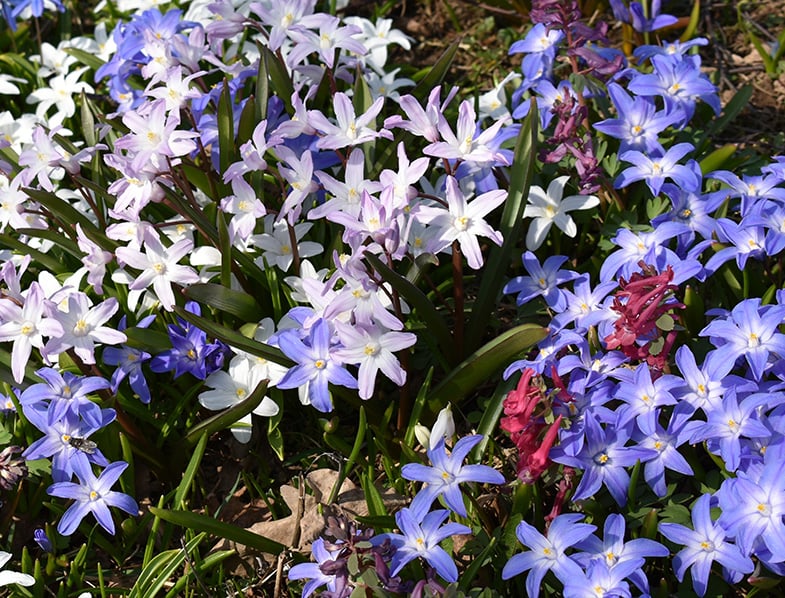Are you looking for a flower that will decorate your outdoor space in early spring? Look no further than Glory of the Snow!
Chionodoxa forbesii, commonly known as Glory of the Snow, is one of the first bulbs to flower in early spring and create a dazzling carpet of flowers in any outdoor space. In fact, Glory of the Snow flowers bloom so early that sometimes the snow is still on the ground. But even if that happens, these flowers manage to emerge gloriously, hence their common name.
This bulbous perennial is a member of the Lily family in the Chionodoxa genus. Glory of the Snow will decorate your garden with its beautiful blooms over many seasons. Once it is established, it will come back year after year at the first sign of spring to remove any winter blues from your garden. Yet, sometimes the flower can become aggressive and spread.
These small flowers come in a wide variety of colours. The blue types are most common, but the Glory of the Snow can also have white and pink flowers. No matter what colour you choose, these flowers will make perfect outdoor plants and cut flowers. And the best part of having Glory of the Snow flowers in your garden is the fact that caring for them is easy and effortless.
Ready to learn more about how to grow and care for Glory of the Snow? Keep reading below!
About Glory of the Snow
- Belonging to the Asparagaceae family, Glory of the Snow is native to Western Turkey, where it can be found growing in rocky mountain areas.
- Chionodoxa forbesii is the botanical name of the Glory of the Snow. This flower is also known as Scilla Sardensis, Scilla Luciliae, Scilla Siehei, Chionodoxa Sardensis, and Chionodoxa Siehei. Its other common names are Bossierțs Glory of the Snow and Lucilețs Glory of the Snow.
- This flower is a fantastic choice for neutralizing lawns, especially beneath trees, if you wish for a carpet of flowers. Glory of the Snow is also an excellent choice for rock gardens.
- Some plants that make great garden companions for Glory of the Snow are Chionodoxa “Pink Giant” (Glory of the Snow Pink Giant), Iris Reticulata “Katharine Hodgkin” (Queen of the Dwarf Irises), and Iris Danfordiae (Dwarf Iris).
- Glory of the Snow is a sun-loving plant. It loves to bask in the warm spring sun but can also adapt to partial shade. So, make sure that you plant it in a sunny spot in your garden.
- In terms of soil preferences, this bulbous perennial prefers to grow in average, medium well-drained soil with a neutral to slightly acidic pH level (6.0-7.0). Like most bulbs, this one is also at a high risk of root rot if it is kept in overly moist soil. So, the soil needs to allow excess water to pass through.
- Glory of the Snow has very minimal watering requirements. In fact, only water your bulb if the spring is particularly dry. Once the flower loses its flower petals, which is a clear sign that summer is just around the corner, you can stop watering your Glory of Snow.
- Like most ornamental bulbs, Chionodoxa forbesii is considered poisonous. In fact, very sensitive persons may even suffer irritation with skin contact. However, the same characteristic to produce irritation makes the flower unattractive to hungry wildlife. So, it is best to be careful when planting your bulbs, but you shouldn’t worry about growing them out of your pets’ reach.
- Glory of the Snow is generally disease and trouble-free. It is deer and critter resistant and doesn’t have any significant pest problems. Yet, don’t forget about its susceptibility to root rot when grown in overly moist soil.

Glory of the Snow Features: An Overview
- Glory of the Snow is a bulbous perennial that can grow up to 5.9 inches (15 cm) high and 3.9 inches (10 cm) wide.
- In early spring, even before the snow disappears from the ground, Glory of snow produces small, upward-facing flowers with a pale blue colour and a white centre.
- The star-shaped flowers feature six petals spreading nearly flat to ½ – ¾ inch wide.
- The most common Glory of the Snow bulbs produce pale blue flowers, but they can also come in white and pink cultivars.
Growing Glory of the Snow
Growing Glory of the Snow is easy. Even inexperienced gardeners will find caring for this bulbous perennial a piece of cake. The flower has minimal growing requirements, and it is pretty resistant to most things that may threaten other garden plants.
When growing Glory of the Snow, remember that the plant prefers to grow in full sun to partial shade. It would be best if you’d find a sunny spot in your outdoor space to plant it. What’s more, if, for example, you decide to use Glory of the Snow as a flower carpet underneath your garden trees, make sure that they get enough sunlight to bloom before the tree leaf canopy develops and starts to create shade.
Another essential thing you should do to help your Glory of the Snow flowers bloom nicely is to feed them in early spring with good bulb food. We recommend using a flower fertilizer that has a 10-10-10 NPK ratio. This will ensure that your Glory of the Snow gets enough nutrients to manage to bloom despite the snow still on the ground.
Pruning is only needed after the flower petals fall off the flower. Then, you need to deadhead the flower and, once summer arrives, cut the stem and the leaves of your Glory of the Snow where it meets the soil. This will help the plant remain protected in the ground until next spring.
Planting Glory of the Snow
Planting Glory of the Snow flowers is just as easy as it is to care for them. If you follow a few simple steps and consider the growing needs of these bulbous perennials, you will definitely enjoy successful planting.
First of all, keep in mind that the right season to plant your Glory of the Snow flowers is in the fall. It’s essential to plant your bulbs when the soil is cooler and the temperatures are no higher than 40-50 °F (4-10°C). Also, make sure that you plant the bulbs before the first frost arrives.
Next, consider the bulb’s most basic growing needs, such as a sunny spot and well-draining soil. To ensure that the soil allows good drainage to avoid rotting, you can mix your native garden soil with coarse sand and crusher fines. Also, make sure that you choose a spot in your outdoor space where these flowers will be well protected from wind and heavy rain.
Once you’ve chosen the right spot, dig a hole 8 inches (20 cm) deep and plant 10 Glory of the Snow bulbs next to each other. Add some fertilizer to your garden soil and fill the holes. Water the spot for about 15 seconds to promote root growth, and then only water the bulbs about once a week in the first month until the bulbs establish.
As the bulbs start growing their first leaves in early spring, add some more flower fertilizer to encourage blooming.
- Vivid Blue Blooms: The Chionodoxa luciliae produce stunning blue flowers that create a serene and charming ambiance in your garden. Their unique shade of blue is a rare treat for the eyes, adding a touch of elegance to your outdoor landscape.
- Low-Maintenance Elegance: Chionodoxa luciliae are known for their easy-to-care-for nature. Plant them in well-draining soil and watch them thrive with minimal effort. Their resilience makes them an excellent choice for both beginner and experienced gardeners.
- Naturalizing Beauty: Chionodoxa luciliae have the wonderful ability to naturalize, meaning they'll multiply and spread over time, creating a more breathtaking display with each passing year. Your garden will become a canvas of delicate blue hues that you'll eagerly anticipate each spring.
- Versatile Landscaping: Whether you're planning a flower bed, a woodland area, or even a rock garden, these bulbs fit seamlessly into various garden styles. Their petite size and graceful form make them ideal for mixing with other spring-blooming plants.
- [100% NON-GMO]: All our seeds are Non-GMO. The seed stock was grown up in the fertile soil in clean ECOLOGICAL AREA’S
- [INSTRUCTIONS IN ENGLISH]: Each package of seeds is provided with detailed planting instructions in English. The instructions are attached to the reverse side of the package
- [LABELED&CERTIFIED]: All seeds are professionally packed and labeled
- [QUANTITY OF SEEDS]: up to 30 seeds. Please note that we are not always able to control the exact amount of seeds in each package. Please LET US KNOW if the product is NOT according to your EXPECTATIONS and we will do all our best to resolve it
Last update on 2024-01-31 / Affiliate links / Images from Amazon Product Advertising API
Watering Glory of the Snow
Watering your Glory of the Snow isn’t going to take much of your time. This bulbous perennial only need watering in specific periods of the year, and, even then, it has minimal water needs.
First of all, keep in mind that overwatering this flower can make the soil overly moist and lead to root rot. Glory of the Snow is also drought resistant. So, it is better to underwater your bulbs than to overwater them.
Watering is only required in the fall, as you plant your bulbs and when the bulb starts blooming during spring. However, watering in spring is only needed if the season is dry in your area. Only water your Glory of the Snow once a week during spring.
Propagating Glory of the Snow
Propagation with Glory of the Snow is often a task that gardeners don’t bother with. That’s because this flower freely self-seeds and often creates colonies of its own kind in the area surrounding it. Yet, if you want to propagate your Glory of the Snow in a different part of your garden, you can do so via bulb offsets and seeds in a cold frame.

To collect seeds from your Glory of the Snow, allow pods to dry on the plant, break them open, and collect the seeds inside. The seeds can be sown directly outdoors in the fall.
To propagate your Glory of the Snow through bulb offsets, simply collect the offsets in the summer and plant them in the fall.
In Conclusion
Glory of the Snow is a fantastic plant to have in your outdoor space. It will be among the first plants to announce the arrival of spring and decorate your garden even before the snow has disappeared completely.
This bulbous perennial is incredibly easy to care for precisely because it has minimal growing needs and it is resistant to various garden threats. To repay your care, your Glory of the Snow will create a fascinating carpet of flowers in your garden in early spring to announce that nature is starting to come back to life after a long winter.




1 Comment
I can’t plant my glory of the snow bull this fall can I add tore them n in a brown sack in my garage and pant in early spring. How late c old I plant in fall like after yhanjsgiving is this possible